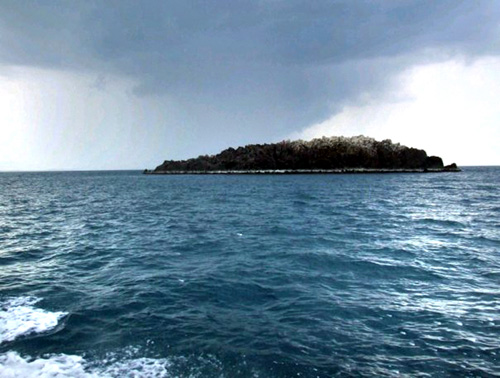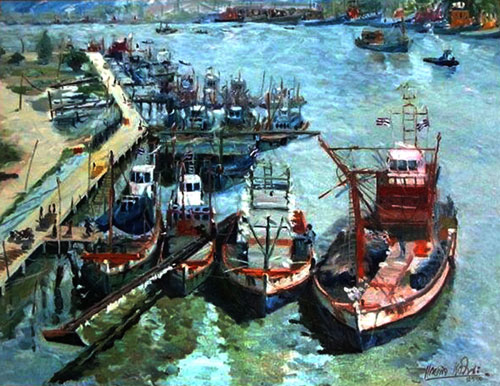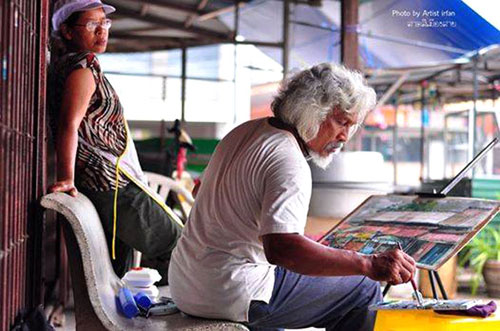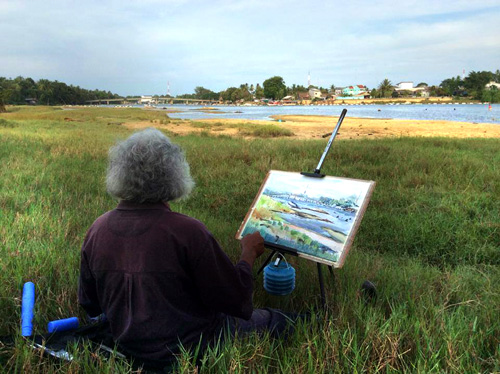|
The Saiburi District in Pattani Province is the first place I was invited to experience a Chinese cuisine lunch at Toyota Phithan Saiburi branch. Saiburi is a strange place to live because in the past Chinese people traveled by boat to reside in Thailand in the Malaya peninsula. The Chinese get along with Muslims very well; they've lived together peacefully in the same villages. The name "Saiburi", derived from Sanskrit, means the city between two rivers under the protection from the wind, under the moonlight. I was excited about that trip because I never rode in a rowing boat before. After lunchtime, the image of the river that day was so green bounded by high grass. Such a wonderful dream to think about. The river by the sea reminded me of Claude Monet's paintings. The sun shone and it was windy.
 |
When I began came to write about the Arts of Thailand, I tried to contact the artists from the south of Thailand to see the progress in cooperation. I spent five years in the south of Thailand and I wanted to communicate with a particular artist. I found a painting of Waearong at the port of Pattani, next to the house in which I lived for three years. In the afternoon, I opened a window to see a group of fishing boats and hawks in the sky. In the South it rained almost every day but the fishing boats and hawks were never afraid of the storm. I saw the picture and asked him (Waearong) on Facebook whether it was Dechanuchit bridge or not. He told me it was not. It was an estuary of Pattani. Nowadays they did not allow fishing boats to dock at Dechanuchit bridge. For almost a year I did not talk to him until the women's group in Saiburi expressed the need to buy Pipit Pakdee Palace back from Chinese people. Then we had a delightful though too brief conversation:
JY: What is special about your latest exhibition "Saad Si Mueang Sai"?
WW: There was an obvious reason why a group of Southern artists joined an exhibition called "Saad Si Mueang Sai". The exhibition was held on 21-22 June 2014. The main focus of the event was a project to bring back a memory of Saiburi: the missing province. Initially, this was my own idea when I heard that Taluban mosque wanted to buy an old palace as a gift for Mueang Sai people. As an artist, at that time I needed a suitable place to exhibit works of me and my group. In my mind, it was so marvelous to hold an art exhibition in a beautiful place just once, especially in a palace. My idea was quite similar to that of the "Saiburi Looker" group which narrated the history of the Mueang.
One day in a café, the Saiburi Looker group and I talked about setting up the exhibition together. This group came up with a wonderful exhibition "Give back memory of Saiburi: the missing province" and I exhibited my paintings with Southern artists. We also discussed how to attract people especially those who lived in Mueang Sai to visit our exhibition. I said that I and my friends in the South Free Art group would like to bring art students from universities and colleges and local artists to a field trip in a village to meet some villagers. Instead of asking some historical questions to villagers randomly, everyone in my team agreed that we should set up a meeting place and welcome all local residents to talk to us. If you ask me, I think it is very difficult to talk about something from memory. This meeting was unexpectedly successful because many local villagers and merchants who came to us provided very interesting information.
 |
Before this meeting, I used to set up a workshop at Baan Suan Kong village, Chana District, Songkla Province. At that time I exhibited my paintings to make people realize the value and beauty of that area. People there had a simple life and most of them were fishermen. After constructing the first port in Songkla Province, an investor wanted to build the second one at this village. If this port was constructed, villagers would have no place to live and work. We all knew that it was a desperate fight against the power of money but we have to object and continue to fight on.
JY: Tell us about yourself?
WW: My name is Waearong Waeno. I was born on 3January 1955. My parents have three children. I was the second son and I have one older and one younger sister. With a passion for drawing and the determination to enroll in Pohchang vocational school, in 1973 I came to Bangkok to work and enrolled in Ramkamhaeng University instead. In 1977 I qualified for the selection test from Pohchang vocational school and I was in the department of international fine arts. Back then not so many men from other provinces passed the test to study in the fine arts department. Most students in the department were former students of this school. I studied there for two years and I got an advanced diploma but there was no Bachelor's degree for my field yet. If I wanted to further my education, I had to select the teaching field which I disliked at that time so I decided to find some work after graduation. An older sister of my senior classmate in Pohchang vocational school was a manager of a company called "Asonar" which made cassette tapes. At first I applied for a messenger position and later I was a salesman and in the end I became a Southern branch manager.
With a better job position, I decided to start my own family. My wife was a Thai-Indonesian who lived in Bangkok and she was also a Muslim like me. We were neighbors during my study at Pohchang vocational school when she studied mechanical techniques. At present I have a son and a daughter and I also adopted a child of my older sister due to the negligence of my older sister's husband. My wife used to work for a Japanese bank called Sakura in Bangkok. Later, my father passed away and we had no one to take care of his house. At the same time, my wife's workplace was merged with another company and many employees were laid off. With these two sound reasons, we decided to move and settle down at my father's house in the South of Thailand and start over. Now she is an English and math tutor for primary and secondary school levels. I was also invited by Darunsat Witya Islamic school to be an art teacher. At first I was not so sure of myself because personally I dislike teaching jobs. The reason why I took the offer to be the teacher and now am still working as an art teacher is because the school gives me so much freedom and I also would like children in the South of Thailand to learn about art in the right way.
 |
JY: Tell us about the South Free Art Group?
WW: This is a small group of artists that was founded to do some art to reflect the way of life in the South of Thailand. Everyone has his/her own proficiency in the way of working. Some of them are lawyers, graphic designers and many of us are full time freelance artists. I am the advisor of this group. Apart from being a teacher, my team and I opened an art equipment store to make picture frames and stationery for all kinds of drawing. And at the time I had important work to do. It was an exhibition for the opening of Rajabhat University Yala in Yala Province. Many art teachers from various art institutes were invited to join. Southern freelancers were also welcomed. The exhibition took place from 13 -15 July 2014.
JY: Any news about the group that would like to buy the Pipit Pakdee palace?
WW: There was definite progress for the purchase of Pipit Pakdee Palace because of harmonious cooperation from Saiburi people but this was only borrowed funds from villagers. Any person who was interested in this could donate some money. Artists who went to set up the workshop were willing to sell their works. If people were interested in art works, they were able to ask artists about the price of a particular painting. Extra income from the sale of paintings was transferred to the fundraising campaign for buying Pipit Pakdee Palace. I and Southern artists from Prince of Songkla University, Rajabhat University Yala, vocational schools and local artists came to help set up the fundraising campaign. As for the price of my works: a painting without frame cost 2,000 Baht and a painting with frame cost 6,000 baht. If one of my paintings with frame was sold, the fundraising campaign would get 3,500 baht/painting. For this exhibition, I accepted a customer's order but the painting style had to be from my idea. I also have prints made from my original paintings as souvenirs. The small print costs 300 baht and the larger one costs 400 baht.
 |
JY: Is there any involvement with the government in your exhibition?
WW: The producer and the team did not want the government to be involved in this exhibition. We, as people of Saiburi, want to tell the story ourselves. Until now, the news on the media about the South of Thailand is all about conflict and turmoil. That is not entirely true. In reality, a Buddhist can befriend a Muslim and vice versa. They can play sports together although their beliefs and society are somewhat different. Currently, many adult Muslims are going to work in Malaysia due to a better economy there and they have no problems communicating with Malaysians. After the end of Ramadan, adult Muslims return to visit their home. The difference can clearly be seen here. Gold shops are full of Muslim women who just came back from Malaysia to buy gold in Thailand. What I said is just one reason so please think carefully. What will happen if people in the South of Thailand are not Muslim?
Fruits including southern langsat (Longkong) have too low a price and the cost of rubber drops. You might wonder why there is no protest from Muslim people. They undoubtedly believe that Allah assigns everything, that Allah provides what is good and satisfying. We will not lay blame on anyone or anything. Although many bad things have happened, we all hope that one day peace will come back to us, with love and faith.
|